Content Hubs and the Best Site Architecture for SEO
From Experts
Ranking on Google and obtaining free organic traffic is one of the most ROI-positive and important forms of inbound traffic generation.
It’s also the most difficult.
Constantly updating your content based on Google’s ever-evolving algorithms can be tricky. There’s matching search intent, optimizing on-page SEO and semantic keywords, link building, content updates, site speed, and a lot more.
And with over 3.5 billion searches done on Google every single day, there are endless opportunities to target new and trending keywords.
So how do you take your SEO to the next level?
How do you future-proof your rankings and climb a little bit higher over your competitors?
The answer: content hubs.
Long gone are the days of a simple blog archive page taking visitors to different blog posts. Readers today expect interactive and navigable content experience with proper site architecture.
In this blog post, we’ll discuss what content hubs are and their role in site architecture and your SEO strategy.
- 1. What Is a Content Hub?
- 2. How Do I Use Content Hubs in My SEO Strategy?
- 3. Why Content Hubs Are Important in 2021 and Beyond
- Recap
1. What Is a Content Hub?
Content hubs (also called content silos) are a series of related web pages arranged in hierarchical order. A content hub features one main page (the hub page) and many other pages (cluster pages) that cover the sub-sections mentioned on the main page. The hub page and cluster pages form a content hub by strategically linking the pages. In short, here are the main elements of a content hub:
- Pillar page. This is the main page that covers a topic comprehensively but not in-depth.
- Cluster pages. Pages that go into greater detail about each section on the pillar page.
- Internal links. Internal links connect the pillar page and cluster pages. The pillar page links to every cluster page, while each cluster page links back to the pillar page.
Examples of content hubs are everywhere. It could be a blog category going to individual product pages on an Ecommerce website. It could be feature pages and sub-feature pages on a SaaS company website. It’s even a way that content websites and blogs organize their important, high-level pillar posts with supporting pages.
Overall, the main goal is to arrange your content in a structure that’s easy to navigate for both users and search engines.
Content hubs help both readers navigate your content and Google to understand the hierarchical nature of your pages and most important content.
2. How Do I Use Content Hubs in My SEO Strategy?
Content hubs are a simple yet very effective way of boosting your SEO. But for them to do so, you must use them well. Here are a few tips on using content hubs in your SEO strategy:
2.1. Start with Proper Internal Linking
Internal linking plays a crucial role in creating effective hubs. That’s why one of the first steps you must take is to map out an internal linking strategy. Strategically linking between your pillar page and cluster pages will help you create an effective content hub. It will also help search engines find it easier to crawl your website.
Strategic internal links also make it easier for users to read your content in a logical order as your pages will be linked according to the proper page hierarchy.
All these are factors that will help boost your SEO as:
- Link equity is passed between the linked pages, helping boost each page’s authority.
- A proper link structure makes for a positive page experience, a significant ranking factor for Google.
Strategic linking seeks to combat the random linking that usually results in haphazard internal linking that plagues many websites. By making sure your links follow a particular structure, search engines can crawl your website much easier. Doing so ensures that you make the best use of your crawl budget.
You need to make sure that your internal links ‘stay in their lane.’ Topic clusters that are topically and semantically related need to be linked together in a cohesive way.
For example, check out this post that ranks for ‘how to start a business’ from SBA.gov:
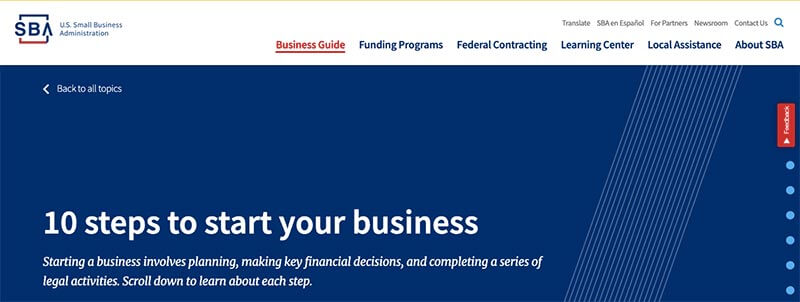
Notice how it isn’t a long-form blog post – it’s a content hub that with very little text. It links to every step that you take rather than covering it all in one individual blog post.
When you click one of the 10 steps like ‘write your business plan,’ you get a content hub architecture that looks like this: /business-guide/plan-your-business/write-your-business-plan
Remember, Google is getting smarter.
As their goal is to organize the world’s content, they crawl articles and understand the relationship and hierarchy between pages.
Proper internal linking to the right pages is step one.
2.2. Create a Parent / Child Page Architecture
To create content hubs for SEO, you must understand and implement parent / child page architecture on your website. This is important as site architecture is a critical component of technical SEO.
So what are parent and child pages?
- Parent page. A parent page is a top-level page that has other pages (child pages) nestled under it.
- Child page. This is a web page that ‘dwells’ under another page on your website.
To determine which posts will be parent pages:
- Determine your niche.
- Research the main topics your audience is interested in.
- Cover the main ‘head topics’ that are broad categories.
As for child pages, you cover your main theme’s different subtopics.
For example, if you have a parent page targeting ‘best web hosting,’ child pages could be the sub-categories underneath:
- VPS hosting
- Dedicated hosting
- WordPress hosting
- Reseller hosting
- Cheap web hosting
- Etc.
Both large brands and blogs can easily implement this strategy.
For example, on AdamEnfroy.com, there’s a main pillar post on the best online course platforms you can see here. It’s a parent page and discusses 17+ online learning platforms.
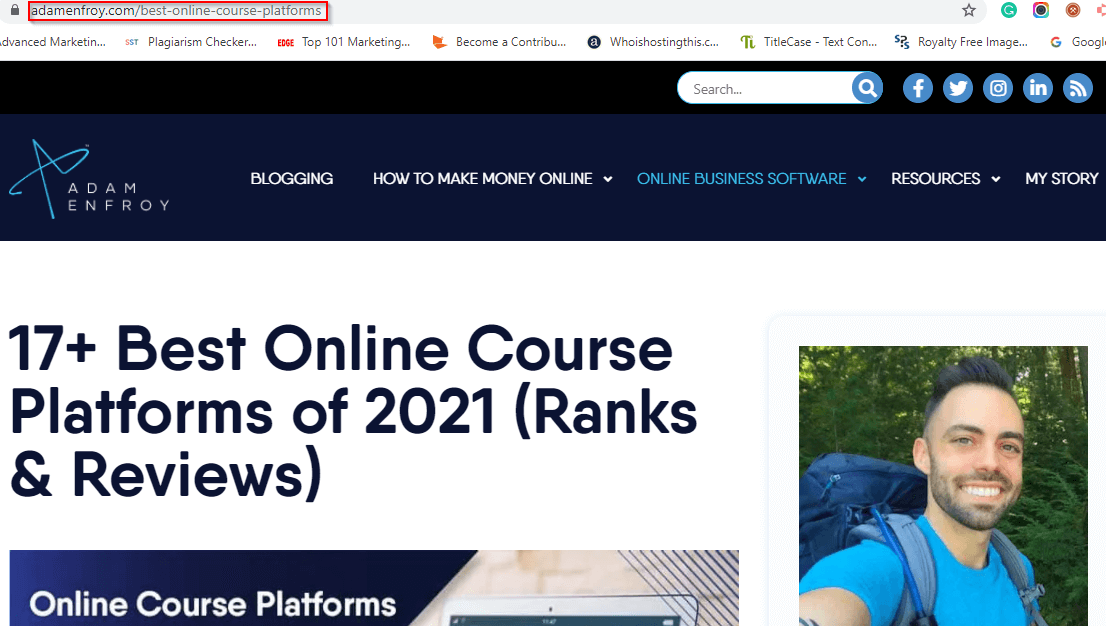
Under that page are child pages based on both individual company reviews, as well as comparison (or ‘vs’) posts:
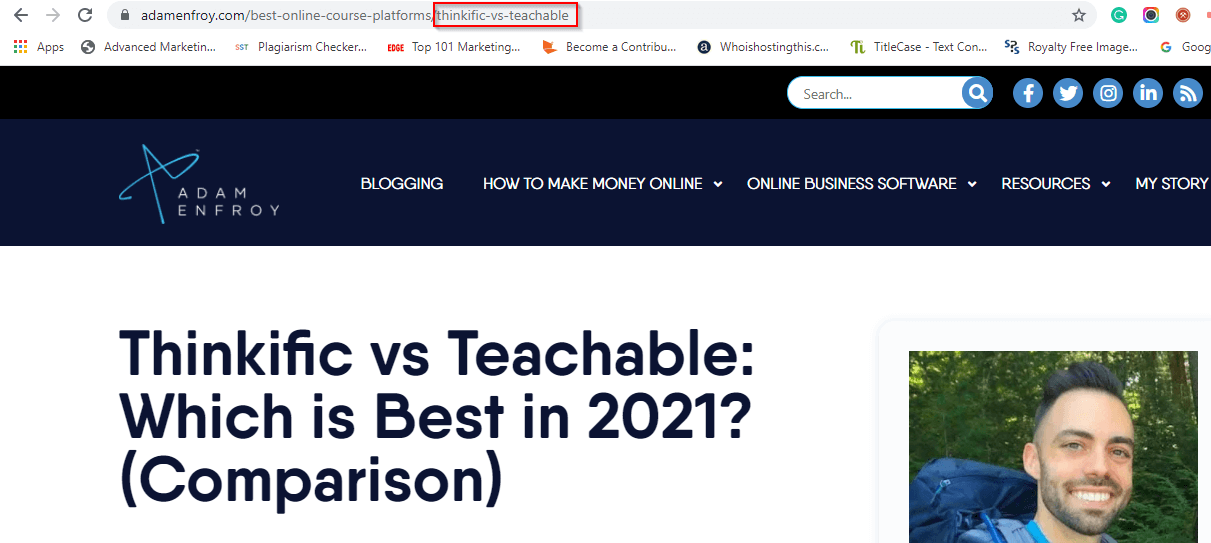
These child pages live under the parent page URL and help organize this content in a hierarchical fashion. Internal links also push link equity from the parent page to the child pages and vice versa.
In summary, your parent pages should cover ‘home run’ keywords that are on broader, high-volume keywords that you’d love to rank for. Supporting content needs to live underneath the hierarchy.
In a way, you’re building a moat around your most important content.
2.3. Create Content Hub pages
Next, it’s time to create your content hub pages. To do this, you should group these similar search intent keywords and:
- Brainstorm topics for your pillar page. Find umbrella terms with a high-volume that other keywords can fall under. Use these to create pillar pages that satisfy search intent.
- Decide on relevant subtopics. Choose which subtopics you’ll cover and create a page that covers each in greater detail. These will be your cluster pages. These can be helpful and supporting articles, or individual steps in a massive guide.
- Create links. Links are the key to creating your content hub pages. Each link should point to a relevant page in the hierarchy, and that in the right order.
BigCommerce has a world-class SEO team and knows what they’re doing when it comes to site architecture and content hubs.
If you want to see the best example of a content hub in action, check out how they’re ranking for the term ‘ecommerce’ with this post:

They have tons of supporting content on the page (basically everything you’d ever need to know to start an Ecommerce business).
To rank for massive keywords like ‘Ecommerce,’ sometimes a single blog post isn’t enough. Users require a unique content experience with supporting articles and every resource they’d ever need.
Another example from AdamEnfroy.com is a page on the ‘How to Build a Blogging Business’ content hub.
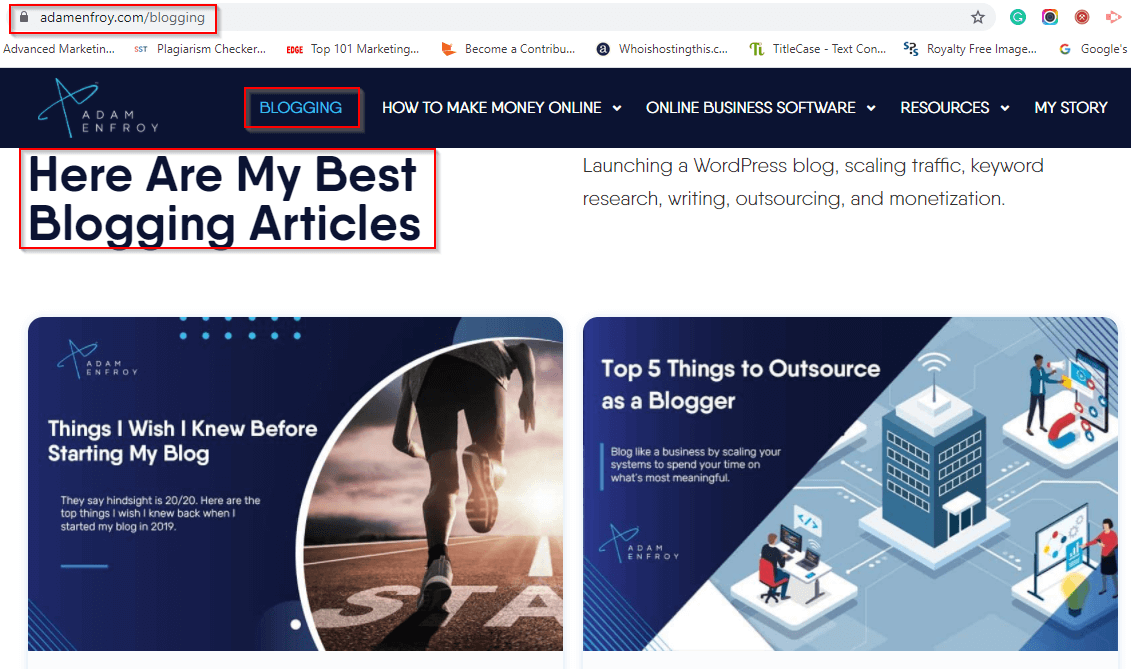
This pillar page links down to important blogging articles, resources, and is more of a content experience instead of just an article. Other pages (cluster pages) that talk about various aspects of blogging are nestled under that page.
To successfully pull this off, make sure to design a content calendar that features a pillar page and the supporting clusters.
To recap, you need to build out the main parent page first and focus your main content updates and link-building efforts on that page. Then your child pages help support that main page with Google knowledge graph relevancy and internal links.
2.4. How to Implement Proper Site Architecture
One of the most significant benefits of content hubs is that you can use them to implement proper site architecture.
One of the main benefits of content hubs is that they help you implement proper site architecture.
Once you’ve determined which pages will be parent pages and child pages, setting them up in WordPress is easy.
Step 1 – create your pillar page
Step 2 –create your cluster page
Step 3 – go to the ‘Page Attributes’ section on the right of the page
Step 4 – click on the parent ‘drop-down’ and select the page you want to nestle your child page
Step 5 – save your changes
You can repeat the same process for every child page you want to create on your website. Structuring your pages this way ensures you have a clean and easy-to-follow site architecture.
Once you’ve done so, you can also add your child pages to your website’s navigation menu.
3. Why Content Hubs Are Important in 2021 and Beyond
For your content to perform well, you must implement content hubs on your website. They’re one way to give your visitors a positive experience on your website. They also help search engines to crawl your website more effectively.
Here are some other reasons why content hubs are important to your content strategy in 2021 and beyond:
1. Content Hubs Organize Content
One of the main reasons content hubs are essential is they help organize content logically on your website. Instead of having related content being scattered across your site in a disorganized manner, site hubs ensure all related content is connected and easy to follow.
This is a crucial aspect of information architecture and is essential to helping users easily navigate your website. They can easily tell where they are on your website, what to do there, and where to go next.
When you organize your content well, it becomes easier for users to discover and digest your content. Of course, the result is they’ll take the action you require of them – be it signing up for your newsletter, making a purchase, or scheduling a call with you. Whatever your end goal, it takes well-structured and organized content to nudge your visitors down your funnel.
2. Content Hubs Lead to a Better User Experience (UX)
Because of how content hubs help organize content on your website, it makes it easier for users to navigate your website. This provides for a better user experience (UX) for your visitors. Besides easy navigation, content hubs help your site visitors get more in-depth content without being overwhelmed on one page.
Creating a good UX also helps reduce bounce rates as your visitors will find it easy to navigate your website and find the information they need. A positive UX also increases the time your visitors spend on your website (dwell time). Both bounce rate and dwell time are the factors that have a significant impact on your SEO.
3. Content Hubs Improve Link Structure
Site architecture plays an important role in both SEO and UX. By creating content hubs on your website, you improve the structure of your internal links, making for great site architecture. Good site architecture makes it easy for search engines to:
- Understand which pages on your site are most important
- Crawl your site
- Understand the central theme of your website
All three are factors search engines use to determine which content to serve users when they input a search query.
4. Content Hubs Help Your Google Knowledge Graph
Google’s Knowledge Graph is a tool Google uses to collate all the facts about people, places, and things. This is done to create interconnected search results synthesized and presented in the form of useful answers called Knowledge Graph Card. Here’s an example below:
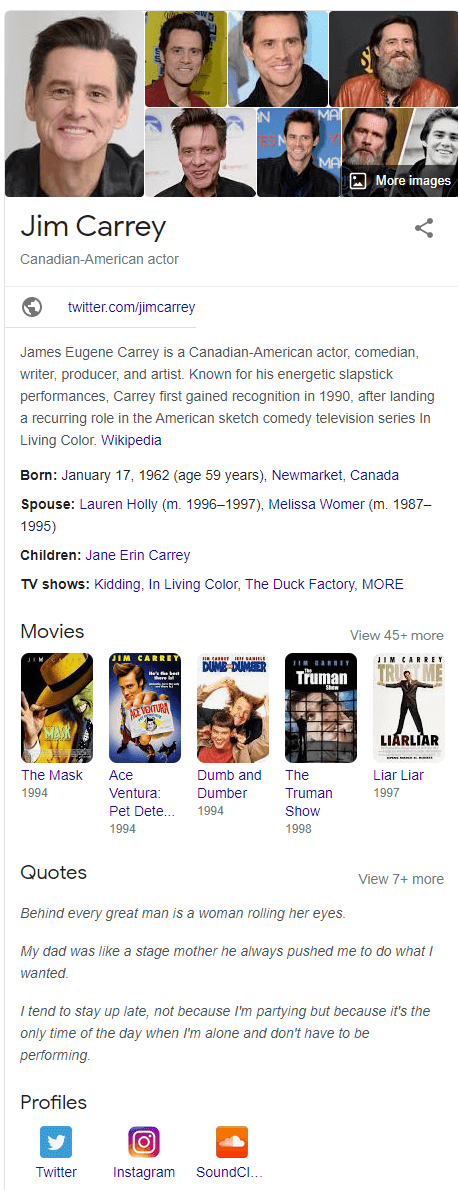
Being featured in the Knowledge Graph Panel is excellent for brand visibility and helps users get in touch with you more easily without visiting your website.
And content hubs are one way you can optimize for Google’s Knowledge Graph. This is because knowledge hubs make it easy for search engines to understand your website better. It also helps match search intent to your content.
Recap
Gone are the days of creating content randomly. If you want to create content that will impact your business goals, you must be strategic about it.
You must carefully design a content calendar that is focused on creating content hubs.
This will make your website a pleasure to navigate, resulting in your content being easy to digest. In short, content hubs help you create a positive UX for users. On the technical side of things, content hubs also make your site architecture easy to crawl. And that’s important as crawlability is an important ranking factor.
So, make sure to:
- Have a proper internal linking strategy.
- Create content hub pages using popular and related keywords that meet search intent.
- Create a parent / child page architecture for easy navigation and crawlability.
- Focus link-building efforts on your parent pages and let that link equity funnel down to your child pages.
Content hubs are that final ‘it’ factor that can push you up in the SERPs, and supercharge your SEO with proper site architecture. Finally, remember to regularly conduct technical SEO audits of your site to ensure every link in your content hub is working.



